Kitchen rug ideas – 10 easy ways to add character to your kitchen floor
Whether it’s a statement piece or a finishing touch, kitchen rug ideas can transform the look of your space Our experts tell you how


A kitchen rug is an easy way to elevate the design of your kitchen. With cabinetry and countertops, flooring and fixtures more likely to be hard surfaces, the introduction of a rug, or two, brings in a contrasting element that is not just visually pleasing but adds character and personality. And when it comes to kitchen ideas, this is definitely an affordable one.
‘As we continue to see the move towards handleless cupboards and structured wall cabinets replaced by shelving, softer surfaces on the floor will add the warmth required to transform the feel of a room,’ says Julian Downes, managing director of Fibre Flooring.
‘Rug and runners introduce color and texture in a room. On-trend color pops can be experimented with and easily moved around or changed without too much cost or upheaval. In smaller kitchens where a larger open plan area with sofas isn’t possible, the comfort factor that comes from rugs on the floor is all the more important. They add a visual warmth and soften noises created by hard surfaces – a nice benefit when the din of a family dining or dinner parties can take over!'
Here are 10 ways a rug can be the perfect kitchen flooring idea without compromising on practicalities…
1. Position a rug so it is parallel to the run of the cabinetry
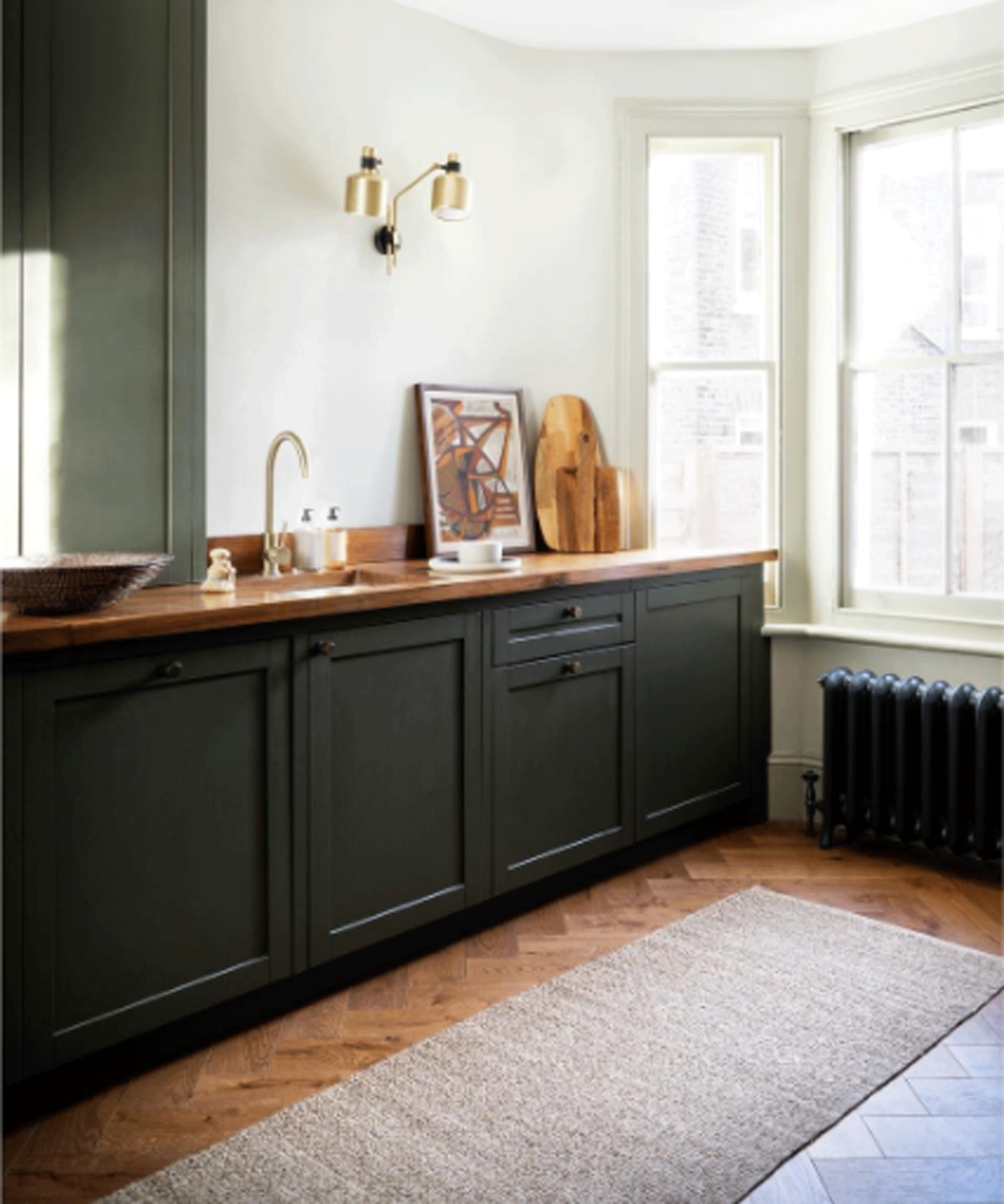
We spend a lot of time in certain work ‘zones’ in the kitchen so adding a rug or runner that mimics the design of the cabinetry is not just soft underfoot but makes the look cohesive like in the design by London-based interiors studio and store Design & That.
‘A rug in a kitchen brings in texture and warmth and helps to soften the space, something like sisal or seagrass is a great hard wearing option.’ says co-founder, Emma Shone-Sanders. A black kitchen is a bold but modern choice. Going for a color that contrasts the dark cabinetry here helps balance the space and makes the kitchen look airier.
2. Add a rug with colourful pattern which complements the walls

It is important to think of the kitchen rug as part of the overall design so consider styles that will contrast, compliment or coordinate with other elements. This vintage Swedish flatweave runner, in the home of Lisa Mehydene, founder of homeware platform Edit58, picks up on the pink on the walls, Dead Salmon by Farrow & Ball part of her appealing kitchen color scheme.
The Livingetc newsletters are your inside source for what’s shaping interiors now - and what’s next. Discover trend forecasts, smart style ideas, and curated shopping inspiration that brings design to life. Subscribe today and stay ahead of the curve.
‘As with all rugs, I love the injection of color and texture they bring to the space,’ says Lisa. ‘Our kitchen is quite muted in palette with yellow, mink, and terracotta tones, so the runners add pattern and interest, in a way that is easy to switch up should I get bored or wish to change things in future. But for now, they are one of my favorite parts of the kitchen.’
Not only does the rug have eye-catching appeal, but it also has a more practical element. ‘We have two children so the rug does a great job of catching any spills and crumbs and are cotton so fully machine washable.’
3. Match a rug to a focal point like a kitchen island for added emphasis

This gorgeous kitchen idea, in the Connecticut home of fashionista Eva Chen is simple in its design but has a key focal point in the form of this deep aubergine island, designed by Plain English, a great modern kitchen island idea.
The vintage runner here captures the tone, which helps enhance the whole space and the diamond pattern adds interest by breaking up the solid colors.
4. Use a rug to help zone an open-plan, multifunctional space
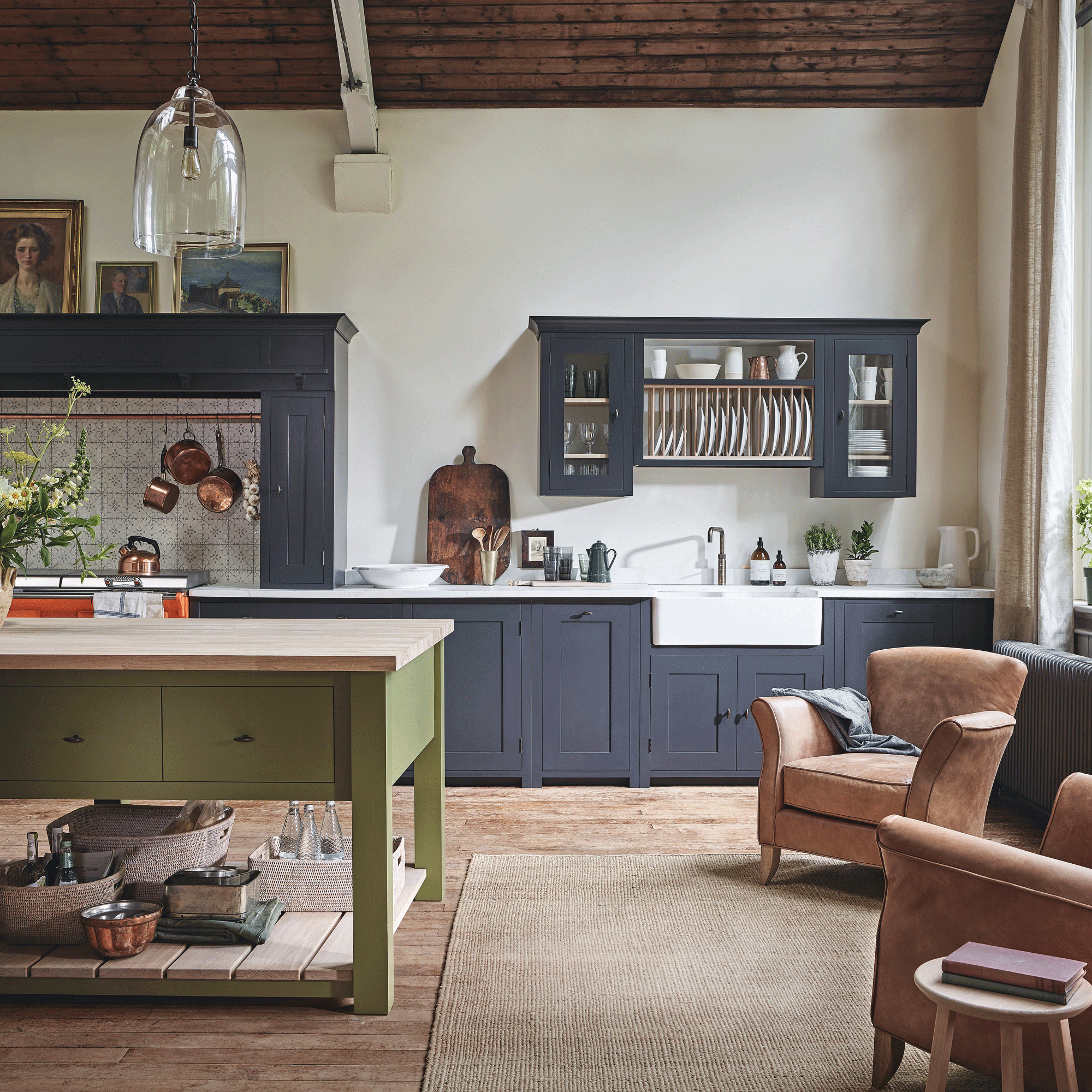
While an open-plan kitchen and living area can work well, particularly in family homes, it is important to define specific areas to avoid visual clutter and ensure the space is truly functional. One way to do this is to use a rug to zone a specific section like the casual seating area in this kitchen by Neptune.
‘This will really make a cozy kitchen feel even more cozy and comfortable,’ says Neptune kitchen designer Stephanie Nix.
‘Depending on the style of your kitchen, colorful vintage rugs can add plenty of character, or if you’d like something more neutral, our Whittington Hemp rug is a natural, mid-honey color made with strong fibers, meaning it is particularly hard-wearing and perfect for the day to day use of the kitchen.’
5. Use your tile backsplash as unexpected rug color inspiration

Your kitchen backsplash choice can help inform other aspects of your kitchen design. More often we think in terms of the countertop or cabinets but this can also extend to the choice of rug, says Jean Stoffer, founder of Jean Stoffer Design.
‘I chose this rug because I love its pattern juxtaposed to the solids of the other materials in the space,’ she explains. ‘One of my favorite color combinations is blue and green, and so I looked for a rug that would bring in some blue to work with the greens in the cabinetry and tile. Lastly, I think vintage rugs bring in an interesting patina to a newly remodeled space. They give it a sense of age and permanence.’
6. Use a runner to visually expand a galley kitchen
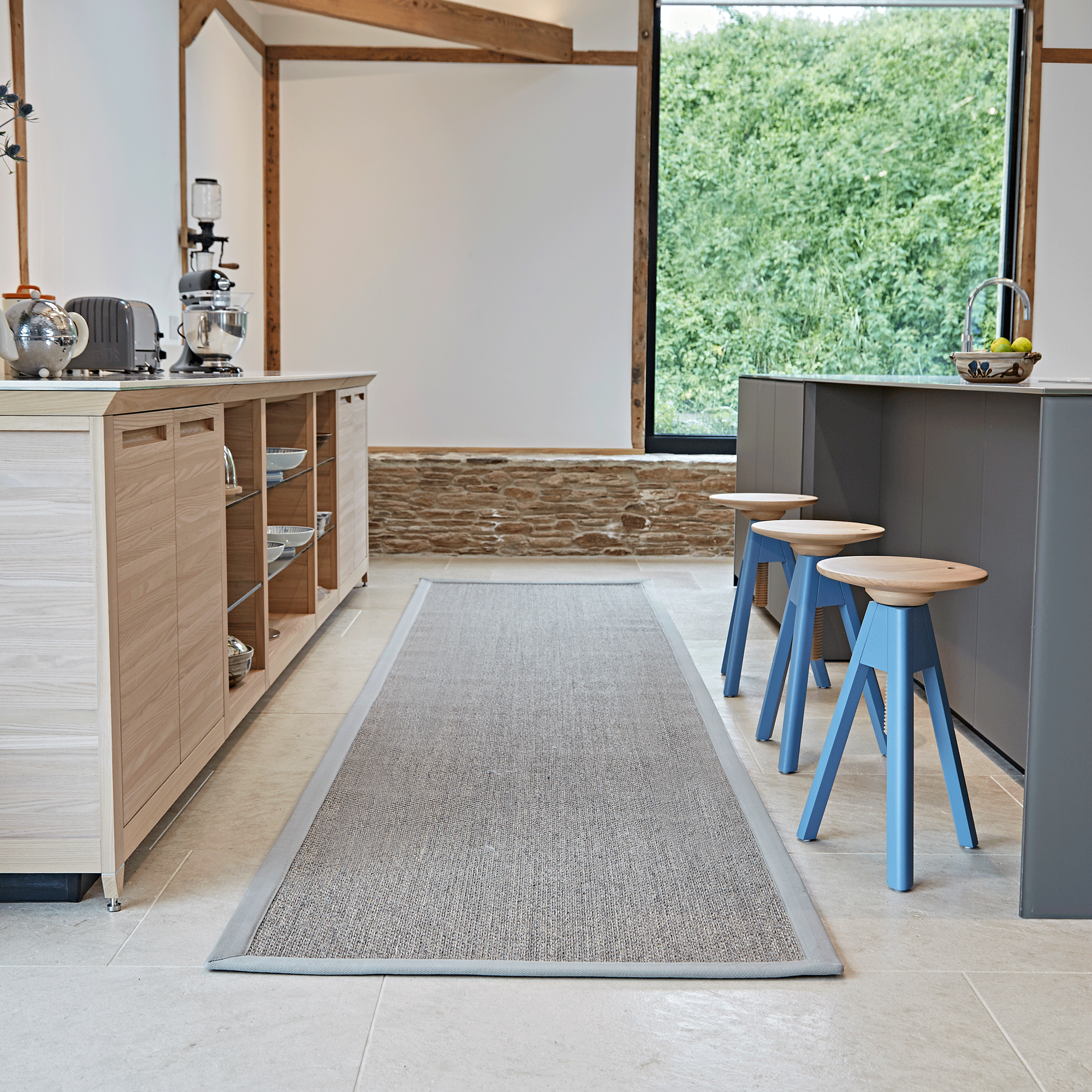
A clever choice of kitchen flooring can make a galley kitchen appear wider. But rather than go into the expense of completely changing your existing floor, you can get a similar impact by having a rug between both runs of cabinets.
‘Galley or narrow kitchens will benefit from the design touch of a runner as they draw the eye through the room, add direction and give an illusion of space,’ says Julian Downes, managing director of Fibre flooring. ‘Choose a chevron or a diamond pattern and this effect will be even greater.’
7. Warm up a stone or concrete floor with a highly textured rug

While a concrete or stone floor can be a very practical choice of kitchen flooring, it can feel quite cold, both underfoot and in terms of design. A flatweave rug is usually recommended for ease of cleaning and convenience but as long as you are happy to take on some extra maintenance, there is no reason why this rule can’t be broken in order to up the cozy appeal.
In this kitchen by Superfront, a rug with a deeper pile warms up the space alongside the wood cabinetry.
8. Go for a high-color rug contrast for a maximalist effect
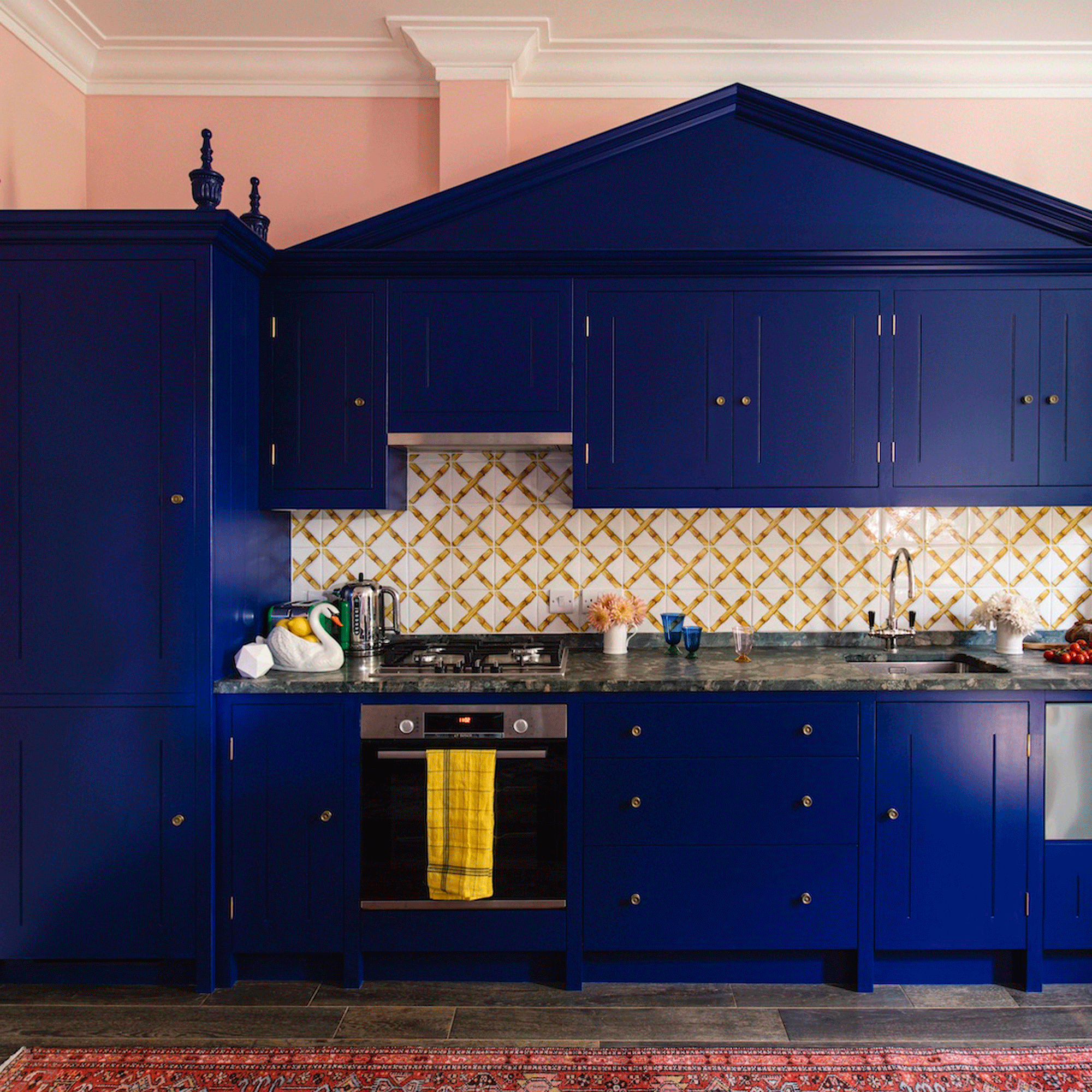
Artist and interior designer Luke Edward Hall lived up to his offbeat image with his British Standard by Plain English kitchen which he decided to paint a striking cobalt blue. And in typical style, he decided to dial up the drama with a rich red and fuchsia patterned rug for maximum impact. ‘I am drawn to quite jarring, odd combinations,’ Luke admits. This individual approach is increasingly popular in kitchen design.
Adrian Bergman, design manager at British Standard by Plain English says, ‘Recently we have found that clients are adding more tactile pieces into their kitchens, items that are usually found elsewhere in the home. Choose a rug that’s forgiving, like a dhurrie or kilim.’
9. Go for a rug with natural fibres for extra durability
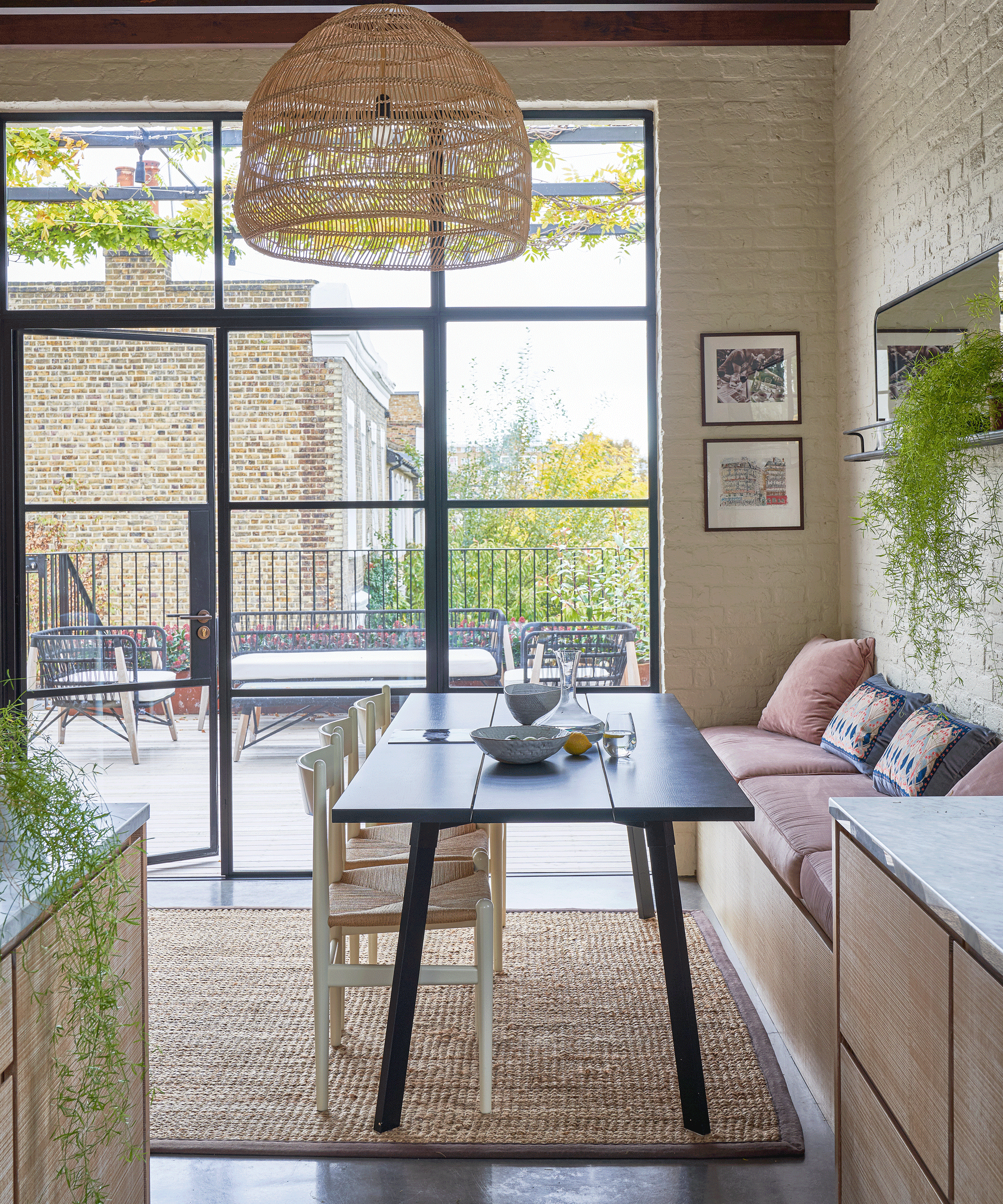
Kitchens can have the biggest traffic in the home so it is important to choose a rug that is durable and it is worth looking into seagrass or sisal rugs for their long-lasting wear.
‘Sisal is a good choice in a kitchen as it adds texture and pattern with the option of color from a rug edging to create a statement,’ says Julian Downes, managing director of Fibre flooring.
‘Sisal is an entirely natural, plant-based material which is hardwearing and, when pre-treated, resistant to stains from dropped food and spilt liquids. It is also suitable for use with under floor heating and blends beautifully with the tones of wood and natural tiles. Opt for a bespoke design for rugs and runners to ensure that the design proportions are perfect.'
10. Use a rug as a neutral base for a colorful scheme
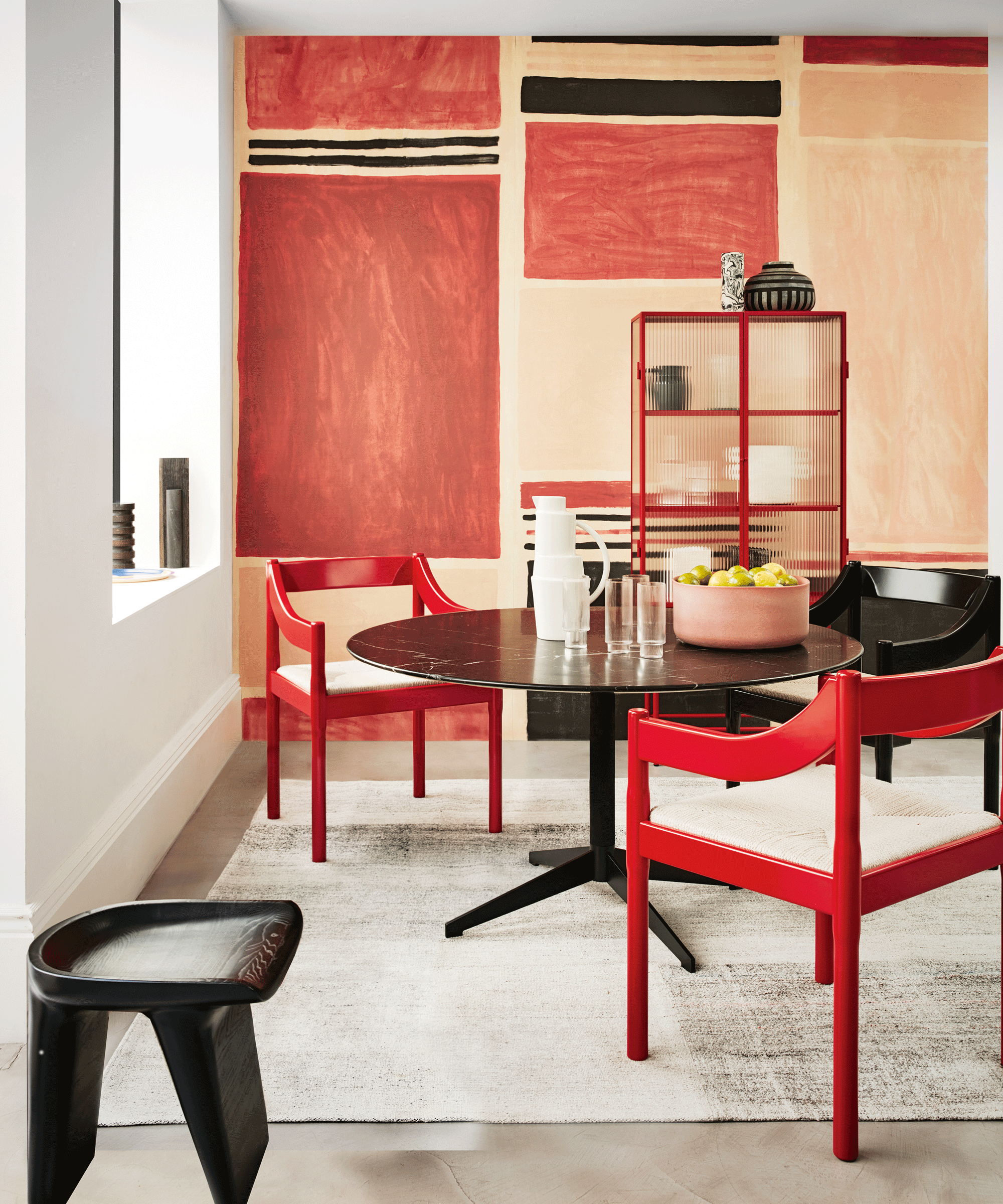
You don’t always need a kitchen rug to stand out – it can be a very helpful supporting act to a more colorful kitchen scheme or dining space that already has an injection of personality. So a neutral rug may be the best option to bring in some calm within a more vibrant design.
But it is important not to overlook the care needed. ‘Rugs in kitchens need to be both hardwearing and easy to clean,’ textile specialist Souad Larusi, founder of Larusi.
‘A good quality Boucherouite rug should be shaken and hoovered regularly although, as they tend to be multi-colored and have wonderful, quirky, irregular patterns, they also disguise a lot of everyday wear. Be sure to use a good quality underlay especially on slippy tiled floors as it’s critical a rug doesn’t become a trip hazard in such a busy area. No wavy edges!’
Should you put a rug in your kitchen?
Rugs are a good idea for a kitchen because it brings in warmth and character as well as being an easy way to inject some color.
‘Rugs are also ideal for zoning different areas if you have an open plan room,’ adds textile specialist Souad Larusi, founder of Larusi.
‘Typically the working kitchen area can be visually differentiated from the dining area. I Ideally the rug will be 36-48 inches longer and wider than your table so that you and your guests can easily slide chairs out without encountering the edge of the rug.’
What kind of rug shall I put under my dining table?
The best rugs to put under your kitchen or dining table should be made of natural fibers like jute and sisal, according to experts. ‘If you opt for a rug under the dining table I recommend a flat weave kilim,’ says textile specialist Souad Larusi, founder of Larusi. ‘In this situation it’s best to avoid deep pile rugs like Beni Ourains.’

The former deputy editor of Livingetc, Busola Evans worked across both print and digital and specialises in kitchens, bathrooms and projects. She is an expert at explaining how to improve, extend and convert your home. Prior to her current role, she was Associate Editor on both Livingetc and Homes & Gardens. A journalist for more than 20 years, she has written for a number of newspapers and magazines including The Guardian, The Sunday Times Magazine and Grazia, and was an interiors columnist for the London Evening Standard's ES Magazine.